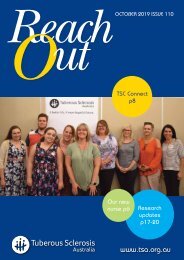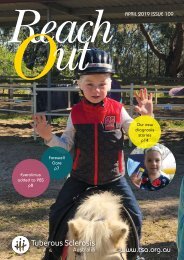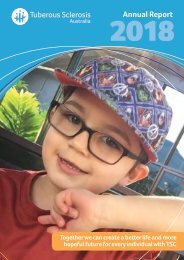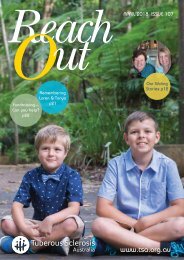Reach Out October 2018
Create successful ePaper yourself
Turn your PDF publications into a flip-book with our unique Google optimized e-Paper software.
Personal Information Stories<br />
of identity separate from their parents, determining the level of<br />
independence from parents, forming deeper relationships with<br />
peers, developing a system of values, increasing cognitive and social<br />
skills and establishing skills for intimate relationships. 12<br />
Medical conditions such as TSC, previously thought to be<br />
primarily of paediatric concern are increasingly entering into the<br />
realm of adult physicians, who may have less experience treating<br />
these conditions than their paediatric colleagues. Evidence from<br />
adolescent patients with other chronic medical conditions tells us<br />
that loss to follow up and poor health outcomes are common. Adult<br />
care is often more fragmented and less holistic than paediatric care,<br />
and this can be a source of concern for people with TSC and their<br />
parents. Parents are often worried that adult physicians may know<br />
less about TSC than their child’s paediatrician, and that they also<br />
tended to focus less on the patient’s psychosocial issues. 13 With high<br />
rates (45%) of psychological distress found in people with TSC, this<br />
is an important aspect of the condition to be addressed regularly. 14<br />
The logistics of seeing several different adult specialists can be<br />
difficult to navigate. Some children’s hospitals have TSC clinics where<br />
patients can see a variety of specialists and allied health professionals<br />
on the one day, facilitating a multidisciplinary approach to care.<br />
More often these arrangements simply do not exist in adult hospitals,<br />
which then requires the patient to visit specialists individually and<br />
potentially on separate days, increasing the risk of loss to follow up. At<br />
At the same time parents<br />
are also adjusting their approach to<br />
caring for their child who, as a young<br />
adult, may wish for more autonomy<br />
and self-sufficiency in their care.<br />
the same time parents are also adjusting their approach to caring for<br />
their child who, as a young adult, may wish for more autonomy and<br />
self-sufficiency in their care. Although ‘guided self-management’ on<br />
the patient’s part is an important part of a successful transition, this is<br />
not always possible with TSC due to the varied ability to self-manage<br />
and function independently from parents or caregivers.<br />
Preparing for a transition to adulthood and<br />
current practice<br />
Early, ongoing and structured preparation is the key to a successful<br />
transition. Discussions around this should ideally begin in early<br />
adolescence and continue at regular intervals. Transitioning should<br />
be seen as a normal part of an adolescent’s overall health care plan.<br />
It should be prioritised in a person-centred manner based on what<br />
is important to the patient. 15 Referrals to adult physicians should be<br />
done well before the intended date of the appointment, as waiting<br />
lists can be long - up to a year or more. Most children’s hospitals<br />
will have a transition coordinator or team who can facilitate the<br />
medical as well as social transition. In individuals who are able,<br />
self-management skills can be gradually learned by attending<br />
doctor consultations without their parents, if only for part of the<br />
appointment. 16 Many patients with TSC will be unable to live<br />
independently and planning for this should be discussed with<br />
their transition team. This includes a discussion around powers of<br />
attorney, advanced care planning and financial supports.<br />
Typically the paediatrician and adult physician will have an overlap<br />
year in which the patient will still see their regular paediatric neurologist<br />
or specialist, but also see the adult physician at the same time. 17 This can<br />
help the patient get used to a new hospital and new faces, and reduce<br />
anxiety that can come from moving out of their comfort zone. Similarly,<br />
if there are any issues that the patient is having with accessing adult<br />
services, these can be discussed while they are still linked in to their<br />
paediatrician. Some paediatricians will continue to see patients past the<br />
typical age of transition due to the complexity of their TSC or difficulty<br />
managing their care in the adult services.<br />
Checklists are often employed by transition teams to help the<br />
patient identify their needs and assess their readiness to transfer.<br />
Checklists can help identify patients who may be at risk and establish<br />
an objective view of what the patient already knows and what should<br />
be discussed further. For example, the Royal Children’s Hospital<br />
in Melbourne uses a checklist to assess whether the adolescent<br />
understands their condition and medications, is able to help<br />
themselves in an emergency and has adequate supports to ensure a<br />
healthy lifestyle. 18 This is especially important with TSC where there<br />
is a wide spectrum of ability to self-manage and be independent.<br />
While it may seem simplistic, checklists provide an easy way to<br />
prevent patients from falling through the cracks by necessitating a<br />
discussion around specific issues that may otherwise be forgotten.<br />
Maintaining continuity of care between<br />
health professionals<br />
Most transition policies recommend that a health care summary<br />
is passed to the receiving specialist when the patient is referred to<br />
them. Some hospitals have templates but not all specialties have their<br />
own tailored transition document. This is an important piece of<br />
information that should summarise the patient’s diagnosis, medical<br />
history, complications, current and previous medications, surgical<br />
history and social situation.<br />
It is also important that the GP is involved in this process.<br />
They can provide continuity of care throughout the transition and<br />
be involved in ensuring the individual is able to live a healthy and<br />
fulfilling life. Further, the GP may be involved in locating neurologists<br />
or other specialists within the patient’s local area. They will have<br />
been involved throughout the child’s life and have a historical record<br />
of the patient’s hospital appointments with specialists and hospital<br />
admissions on file. The GP is a valuable constant during a time of<br />
change. Unfortunately, many people with chronic health conditions<br />
requiring specialist attention do not have a regular GP.<br />
Potential improvements in the process<br />
Transition clinics involving the paediatrician and adult physician<br />
collaborating side by side could be one way to facilitate the process.<br />
Successful transition clinics in other countries have shared<br />
several key attributes - a formal transition process, persistent and<br />
dedicated health care staff, sufficient staff, and a close working<br />
relationship between the paediatricians and adult physicians. 19<br />
However, studies of multidisciplinary transition clinics have also<br />
found that financial costs and organisational barriers were difficult<br />
to work with and could risk the long term success and expansion of<br />
these clinics. 20 These barriers, however, may be representative of a<br />
general lack of knowledge as to how important this period is to the<br />
long term health of individuals with chronic medical conditions.<br />
A specialised TSC clinic for young adult patients could be one way<br />
to ease the transition for patients and facilitate communication<br />
between specialties. This has been implemented at Sydney<br />
Children’s Hospital with great success.<br />
Adolescence is a period rife with changes for all young<br />
17





![TSA Reach Out April 2022 [Final]](https://documents.yumpu.com/000/066/687/587/3d369bd665bdb406a759500f62e2cfad0ccb7b3d/47512b4a703265727550565249426664566a727454513d3d/396a524e7354316d3867454b587243526164724c52673d3d.jpg?AWSAccessKeyId=AKIAICNEWSPSEKTJ5M3Q&Expires=1716685200&Signature=UsVN9u%2F4Lk0a5L5N1qhRpjIunFw%3D)
![TSA AR 2021 [WEB] (1)_FINAL](https://documents.yumpu.com/000/065/886/431/1afb21934ac6c444cd384e5fd7403d62e47080ce/426853747566526573646568546777594b4a4a5734513d3d/547274595943503850786275754544495972536c52513d3d.jpg?AWSAccessKeyId=AKIAICNEWSPSEKTJ5M3Q&Expires=1716685200&Signature=Ag0bD8ufcJqGQzqDQBkJk%2BPd%2F7w%3D)

![TSA Reach Out Apr 2021 [WEB]](https://documents.yumpu.com/000/065/442/909/1e583cb2acba0eaa7f1aae53e14a0cf408aa56c4/7871796d694459464d707163324830746459484671673d3d/45356637637a3369494f764f4c3858495549795251513d3d.jpg?AWSAccessKeyId=AKIAICNEWSPSEKTJ5M3Q&Expires=1716685200&Signature=lxg3uWLNsj1F4ktvy%2BWPGIjfEQk%3D)








